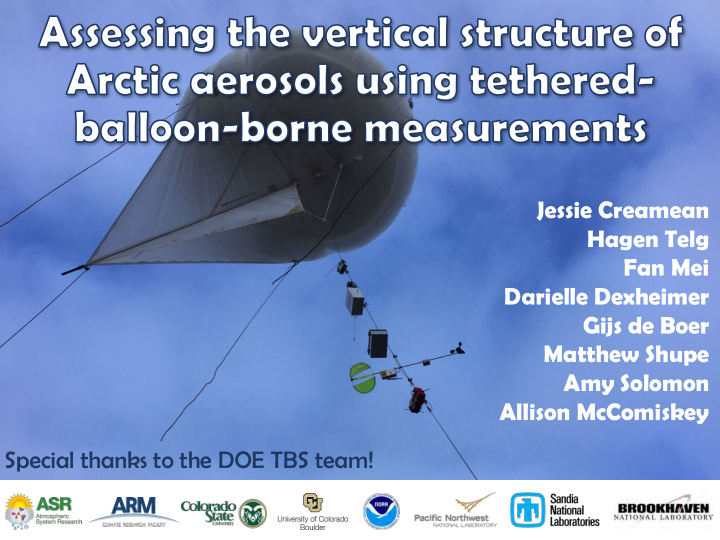



Jessie Creamean Hagen Telg Fan Mei Darielle Dexheimer Gijs de Boer Matthew Shupe Amy Solomon Allison McComiskey Special thanks to the DOE TBS team!
• The Arctic atmosphere often highly-stratified • Effects on aerosol-cloud interactions • Very few routine vertical measurements of aerosols • Remote sensing limited by coverage, cloud interference, surface brightness and returns, quantification • Traditional aircraft are logistically/financially demanding, offer “snapshot”, cannot reach ground • TBS can fill observational gap between surface and traditional vertical measurements Are ground-based : D aerosol measurements representative of those aloft?
ARM TBS campaigns on the North Slope # of Campaign Dates flights Inaugural Campaigns for ARM Research using Unmanned Systems (ICARUS) May, Aug, Oct 2017 14 Aerosol Vertical Profiling at Oliktok Point (AVPOP) May 2018 4 Profiling at Oliktok Point to Enhance YOPP Experiments (POPEYE) Jul, Aug, Sep 2018 28 Main TBS instruments: POPS • iMet • Also used… Ceilometer • KAZR • UHSAS • Creamean et al., 2020, in prep for ACP
Flights cover a wide range of Overview of “typical” flights conditions and time periods Creamean et al., 2020, in prep for ACP
Flight statistics: Breaking down the profiles Scavenging at cloud base (most in spring) • More at the ground compared to BL, except for summer (regional fires? May = • summer?) Highest concentrations in summer (ground same as spring, less in fall; local NPF?) • Highest concentrations aloft, in summer • Creamean et al., 2020, in prep for ACP
The big picture, based on statistics Lots of clouds • Not well- • mixed Most aerosol • below cloud, in layers BL mixing • reflects aerosol structure Cloudiest in • summer, most aerosol Precipitation • anti-correlated Most layering in spring Creamean et al., 2020, in prep for ACP
• TBS provides key information on aerosol vertical structure • Ground aerosol = cloud base 32% of the time, BL mixed 23% of the time. Layers most of the time. • Contrary to previous work suggesting haze = more aerosol, we saw more in the summer BY NUMBER (similar to Utqia ġ vik) • Wet scavenging can help explain numbers • Thermodynamic conditions can explain aerosol vertical structure 67% of the time Hey! Use our data! Soon to be a PI product
Recommend
More recommend